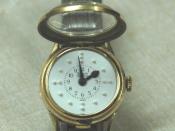Seeing beyond stereotypes enables a person to have healthier relationships. Stereotypes build walls between two people that prevent them from truly knowing each other. In this story, the husband overcomes his stereotypes and is able to pave the way for a relationship with the blind man.
The husband dreaded the arrival of Robert because of his stereotypical ideas of blind people. He stereotypes blind people, for example, when he says, "My idea of blindness came from the movies. In the movies, the blind moved slowly and never laughed." (289) This statement lets the reader know that the husband has never known a blind person before and only knows about blind people from what he has seen in the movies or on television. He wrongly assumes that blind people are slow and unhappy because these are the characteristics that he has seen associated with blind people on TV. Later on, when the wife shares the story about the blind man's relationship with his wife, the husband seemed to pay attention only to his ideas of the kind of husband a blind man could make, instead of the romantic story of the blind man's relationship told by his wife. "What a pitiful life this woman must have led. Imagine a woman who could never see herself as she was seen in the eyes of her loved one. A woman who could go on day after day and never receive the smallest compliment from her beloved."(291) This comment stereotypes that blind people can't compliment because they can't see appearances. He never takes into consideration that blind people have other senses that can receive information to base their compliments on. In order to have a healthy relationship with the blind man, the husband is going to have to see past his negative stereotypes and understand the lifestyle of the blind man.
Throughout the story, the husband learns that the blind man is equal to any man, with or without sight. As the husband learns more about the blind man, his negative stereotypes of blind people begin to dissolve, allowing the husband to see the blind man in a different light. By abandoning his pre-existing stereotypes, the husband is able to get a better understanding of the blind man, leading to a better relationship. For example, when the husband first sees the blind man, he says, "This blind man, feature this, he is wearing a full beard! A beard on a blind man! Too much, I say."(291) The exclamation and repetition of "beard" shows that the husband didn't think a blind man could take care of a beard, and is surprised. The husband seems almost upset that a blind man is able to care for himself as any other man. However, the husband's viewpoint of the blind man's beard changes with each mention in the story. Allthough at first the husband implied that a blind man should not be able to care for a beard, later on he suggests that the care the blind man shows for his beard signifies his intelligence. Whenever the husband notices the blind man tugging his beard, he associates it with listening and processing information. For example, when he says, "Now and then he put his fingers into his beard and tugged, like he was thinking about something he was hearing on the television."(296) As the husband notices this, he begins to realize that the blind man can function for himself like any person with sight. The way the husband described the blind man when he first arrived is no different then if he were to describe any other middle-aged man. He says, "This blind man was late forties, a heavy-set balding man with stooped shoulders, as if he carried a great weight there. He wore brown slacks, brown shoes, a light-brown shirt, a tie, and a sports coat. Spiffy. He also had this full beard. But he didn't use a cane and he didn't wear dark glasses. I'd always thought dark glasses were a must for the blind." (292) The husband's description could be applied to many middle-aged men, with or without sight. Even though Robert is blind, his clothes matched, and his beard was well kept. He even carried tension in the shoulders like most middle-aged men. The husband's description wasn't at all like what he expected a blind man to be. He was well kept, without a cane, and didn't hide his blindness behind glasses. The next example of the husband's enlightenment is when he compares himself to the blind man. The husband compares the blind man to himself when he says, "We were into serious eating. The blind man had right away located his foods, he knew just where everything was on the plate. I watched with admiration as he used his knife and fork on the meat."(293) This example insinuates that the husband didn't expect the blind man to have similar eating habits as himself. He seemed to think the blind man would take his time and have more trouble finding the food on his plate. In this example the husband seemed more accepting of the blind man because the husband watched in admiration instead of astonishment. The husband's realizations about the blind man's behavior and appearance helps him to overcome his stereotypes and see the blind man for what he is, allowing a relationship to develop.
The blind mans willingness to listen and learn from the television show at the end of the story causes the most dramatic change in the husband. The blind man says, "It's fine with me. Whatever you want to watch is okay. I'm always learning something. Learning never ends. It won't hurt me to learn something tonight. I got ears (296)." The husband hears this and seems to realize that he hasn't been listening to the people around him. His stereotypical ideas had blinded him from the people around him, preventing him from seeing the truth and only judging by what he had seen in the movies. While watching the program on cathedrals, the husband realizes the blind man may not know what a cathedral is. The husband shows he has a better understanding of the blind man when he inquires about his knowledge of cathedrals. This is the husband's first attempt to be hospitable to the blind man by considering the way being blind affects a person's lifestyle. If the husband didn't pay as close attention to the blind man he would not have considered explaining the cathedrals appearance to the blind man. The husband was able to come to a full understanding of the blind man when explaining the cathedrals appearance through a drawing. The narrator says, "Close your eyes now, the blind man said to me. I did it. I closed them just like he saidâ¦I think you got it, he said. Take a look. What do you think? But I had my eyes closed. I thought I'd keep them that way for a little longer. I thought it was something I ought to do."(299) When the husband closed his eyes and continued to draw, he was able to fully understand the lifestyle of the blind man. His understanding came through the personal experience of acting without the ability to see. The husband, feeling that he should keep his eyes closed, shows that he is learning without seeing, the way the blind man does. This helps him to complete his understanding of the blindman.
The most important thing the husband learned from the blind man is not to judge a person before getting to know them. The husband would have never seen the blind man in the way his wife had if he never broke down his wall of stereotypes. Now that the husband has learned to see beyond stereotypes he will be able to build a relationship with the blind man.





